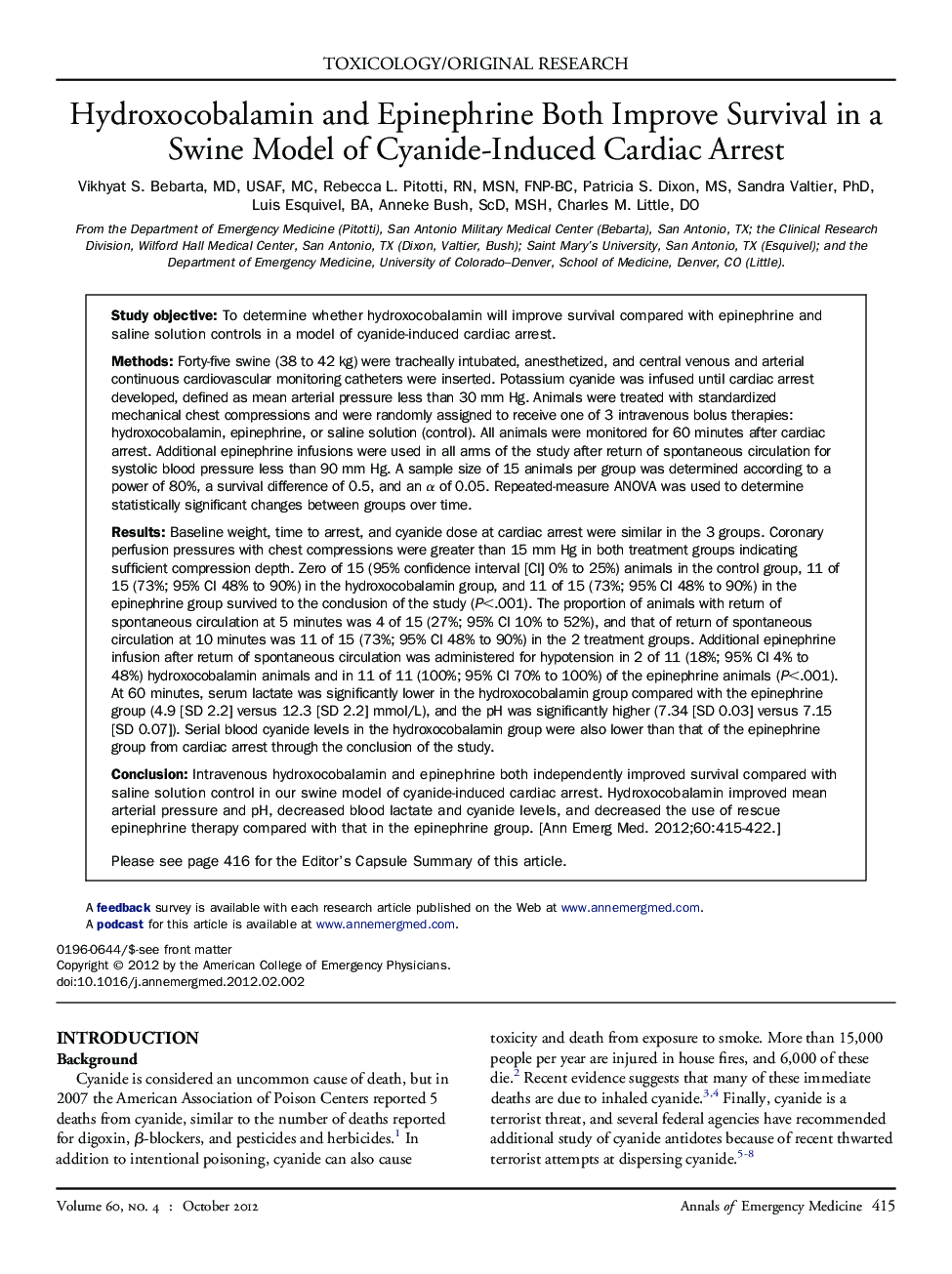| کد مقاله | کد نشریه | سال انتشار | مقاله انگلیسی | نسخه تمام متن |
|---|---|---|---|---|
| 3230171 | 1588553 | 2012 | 8 صفحه PDF | دانلود رایگان |

Study objectiveTo determine whether hydroxocobalamin will improve survival compared with epinephrine and saline solution controls in a model of cyanide-induced cardiac arrest.MethodsForty-five swine (38 to 42 kg) were tracheally intubated, anesthetized, and central venous and arterial continuous cardiovascular monitoring catheters were inserted. Potassium cyanide was infused until cardiac arrest developed, defined as mean arterial pressure less than 30 mm Hg. Animals were treated with standardized mechanical chest compressions and were randomly assigned to receive one of 3 intravenous bolus therapies: hydroxocobalamin, epinephrine, or saline solution (control). All animals were monitored for 60 minutes after cardiac arrest. Additional epinephrine infusions were used in all arms of the study after return of spontaneous circulation for systolic blood pressure less than 90 mm Hg. A sample size of 15 animals per group was determined according to a power of 80%, a survival difference of 0.5, and an α of 0.05. Repeated-measure ANOVA was used to determine statistically significant changes between groups over time.ResultsBaseline weight, time to arrest, and cyanide dose at cardiac arrest were similar in the 3 groups. Coronary perfusion pressures with chest compressions were greater than 15 mm Hg in both treatment groups indicating sufficient compression depth. Zero of 15 (95% confidence interval [CI] 0% to 25%) animals in the control group, 11 of 15 (73%; 95% CI 48% to 90%) in the hydroxocobalamin group, and 11 of 15 (73%; 95% CI 48% to 90%) in the epinephrine group survived to the conclusion of the study (P<.001). The proportion of animals with return of spontaneous circulation at 5 minutes was 4 of 15 (27%; 95% CI 10% to 52%), and that of return of spontaneous circulation at 10 minutes was 11 of 15 (73%; 95% CI 48% to 90%) in the 2 treatment groups. Additional epinephrine infusion after return of spontaneous circulation was administered for hypotension in 2 of 11 (18%; 95% CI 4% to 48%) hydroxocobalamin animals and in 11 of 11 (100%; 95% CI 70% to 100%) of the epinephrine animals (P<.001). At 60 minutes, serum lactate was significantly lower in the hydroxocobalamin group compared with the epinephrine group (4.9 [SD 2.2] versus 12.3 [SD 2.2] mmol/L), and the pH was significantly higher (7.34 [SD 0.03] versus 7.15 [SD 0.07]). Serial blood cyanide levels in the hydroxocobalamin group were also lower than that of the epinephrine group from cardiac arrest through the conclusion of the study.ConclusionIntravenous hydroxocobalamin and epinephrine both independently improved survival compared with saline solution control in our swine model of cyanide-induced cardiac arrest. Hydroxocobalamin improved mean arterial pressure and pH, decreased blood lactate and cyanide levels, and decreased the use of rescue epinephrine therapy compared with that in the epinephrine group.
Journal: Annals of Emergency Medicine - Volume 60, Issue 4, October 2012, Pages 415–422